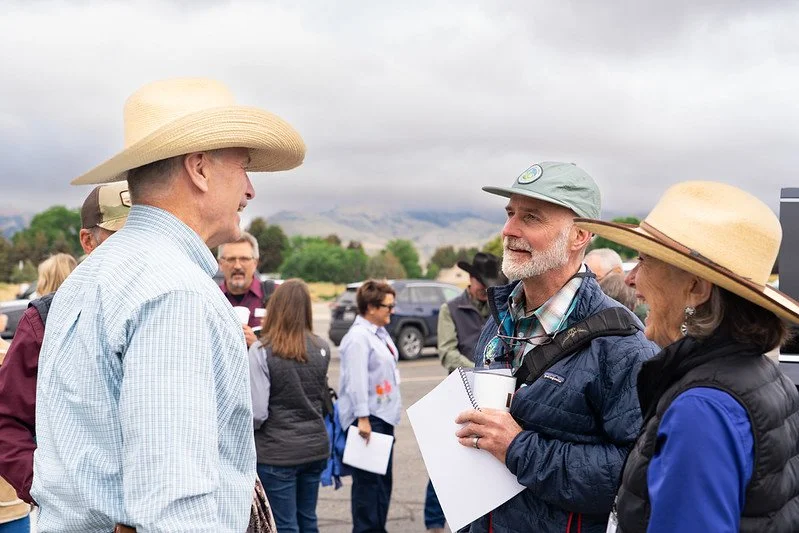Building Connections: East Yellowstone Collaborative’s Working Lands Tour with Wyoming Governor Mark Gordon
Governor Mark Gordon (Front Left), LegacyWorks Group Founder Carl Palmer (Front Center), East Yellowstone Regional Director Laura Bell (Front Right) | Photo Credit | Greater Yellowstone Coalition/Emmy Reed
In a remarkable demonstration of collaboration and commitment to Wyoming's natural heritage, the East Yellowstone Collaborative (EYC) recently hosted a Working Lands Tour with special guest Wyoming Governor Mark Gordon and a group of key legislative and community partners. This event, held in July 2025, took participants through four area ranches where they heard directly from landowners about how their working land stewardship efforts support migratory wildlife.
At the heart of this work is the USDA-Wyoming Migratory Big Game Initiative, developed back in 2022. This program originated from a series of listening sessions where landowners voiced their concerns about the challenges of accommodating abundant wildlife populations on their properties. During these discussions, they provided valuable insights and practical solutions for protecting their working lands. Recognizing the significance of these conversations, Governor Gordon emphasized the urgent need for sustainable practices that would enhance both community trust and environmental health.
Governor Mark Gordon | Photo Credit | Greater Yellowstone Coalition/Emmy Reed
"Wyoming leads the country on our migration corridor work because we respect private property owners. We have an incredible opportunity here to continue to cross boundaries and work together on big game migration," Governor Gordon said.
The working farms and ranches of Wyoming's Absaroka Front serve as essential habitat for migrating elk, deer, pronghorn, grizzlies, and wolves of the Greater Yellowstone Area, which depend on the low-elevation forage to survive the harsh winters. The Initiative has made significant strides to support these working lands by funding conservation easements, habitat leases, and critical restoration projects, including wildlife-friendly fencing and invasive cheatgrass treatments.
"The success from these landowner-focused initiatives is evident. Together, we should be celebrating the importance of agriculture and ranching more, as well as the importance of private property to wildlife populations, landscapes, communities, and our State's culture,” said Governor Gordon.
In the years following the Initiative's announcement, EYC has diligently worked to engage landowners and managers, facilitating outreach through personal visits, neighborhood gatherings, and community events. This grassroots approach has not only spread awareness but has also fostered stronger relationships among community members and local partners.
Photo Credit | Greater Yellowstone Coalition/Emmy Reed
"This has been such a unified effort from the federal level to the state in support of working lands and wildlife migrations in the Greater Yellowstone Region," said EYC facilitator and LegacyWorks' East Yellowstone Regional Director, Laura Bell. "What makes this initiative so unusual is how closely landowners were involved in shaping it from the start."
The Working Lands Tour served as a platform to amplify the voices of landowners and celebrate the successes achieved through the Initiative. By showcasing tangible outcomes, EYC aims to build broader support for ongoing funding and collaboration, ensuring that Wyoming's working lands remain sustainable for future generations.
This dedication to collaboration, trust, and long-term conservation truly highlights the spirit of Wyoming. Together, we can continue to protect our invaluable landscapes and the migratory wildlife that call them home.



